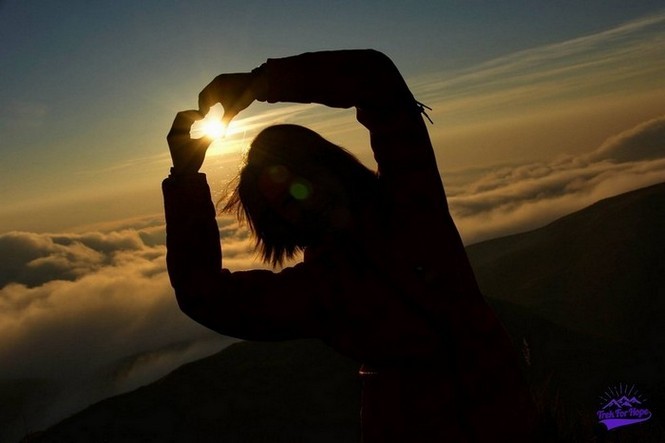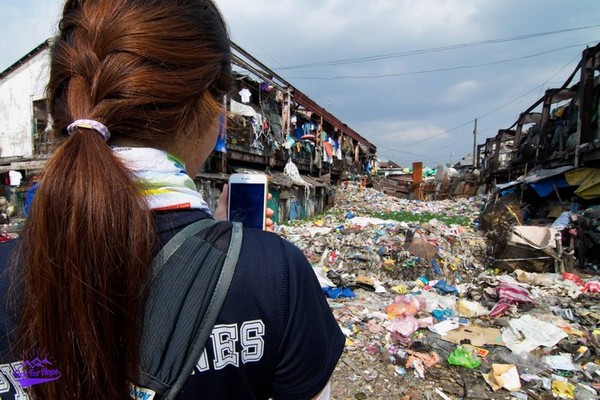”A mind that is stretched by a new experience can never go back to its old dimensions.” Oliver Wendell Holmes, Jr
This sharing is a continuation of the earlier personal story of our expedition and hike in Philippines and coming to Happyland slums.
Trek for Hope Part 2: Hope in Happy Land

Continuation from Part 1 : Twin Peaks of Grand Corderilla...
SMOKEY MOUNTAIN PHILIPPINES – Amidst the beautiful mountains of Philippines that we trekked and lived to remember , sits a mountain unique of its kind – a 2 million metric tons of waste ‘mountain’ in the heart of Tondo Manila that housed millions of people for over 40+ years.
After trekking for 4 days in the wilderness of Mount Ugo and Mount Pulag, it has brought us back to the Philippines capital of Manila with energy and desire to do something for the impoverish people of this beautiful country. This was done alongside partner non profit organization (NGO) – Oikos Helping Hand.

In 1995, the removal of Smokey Mountain has lead to the creation of a new Smokey Mountain to ‘house’ the vacated – and nested in the heart of these new temporary ‘refugee camps’ is the slums of ”Happyland Tondo” and ”Aroma”. The names till date, still cause my stomach to churn whenever I recall the twisted irony of it.



The name “ Happyland ”…
…is derived from the Visayan dialect’s name for smelly garbage: Hapilan, a slum made up of many mini dumpsites put together. The most common type of trash seen here is from the large fast food chain in Philippines Jollibean, where the scavenger sort the different types of packaging and leftover food from cups to straws to spoons.The leftover food gets recooked into ‘pag pag’ and is actually re-consumed by the scavengers.


While other parts of Philippines like Coron island, Boracay and Cebu are full of sparkling crystal blue waters, here by the riverside of Manila, its a different situation.

Smokey Mountain Tours and visit

The team of 22
…from the Trek for Hope expedition broke into groups of 5-6 to conducted food ration giveaways to some of the residents of these homes/ slums. We interacted and talked to them to understand their lives better/ and perhaps to just be a friend or listening ear. Some of these residents or scavengers we visited in Happy Land lived just to get by each day rummaging through rubbish to find something valuable. A lot of them really depend on Agapehome (supported by Oikos Helping Hand) to help them – be it house their children, provide them food or hopefully help them and their families break out of the poverty cycle.


The condition of the Philippines Tondo Slums

Homeless in Manila? Or not

Other than the house visits and smokey mountain tour we had, we also had a full day community event held at Agapehouse, (by Oikos Helping Hand) where all the scavengers from the slum areas are invited over to the premise to enjoy some singspiration/ games/ food/ activities and bring home some smiles and gifts to their respective homes.



GVING HOPE – as a mere human, how can we claim that we truly understand what that means? Does going down 1 -2 times to visit these people and pulling out some money solve everything? What do we understand about the everyday battle of these residents as they worry about the survival of their newborn or the next disaster that will strike that will shaken their very survival.

In a place where there is too much need and cry for help, how can organizations dare to promise to make big changes overnight, and give a clear timeline what can be done by when, even if they are given a one off sum of donation.
However, through the few days we were there to help and be involved, what we realised mattered most was the human spirit/ spiritual love – a responsibility, compassion and continual persistence to want to help others that keeps us going and doing it. Nobody can guarantee to provide these people a pain free life, but perhaps through the little things, help them know there is something good and better that can get them through the day, and to the next.


HOPE – It isn’t wishing for the best.
It isn’t waiting to see what happens and hope that it turns out well. Hope is not a feeling or an emotion. Hope is the knowledge of facts. If someone says to you that “I hope you have a good day,” there is no guarantee that the day will go well. But hope provides an anchor for the soul that there is something good beyond the current pain, and this anchor once fostered, cannot be destroyed.


—
This amazing trip was made possible in partnership with Trek for Hope and Oikos Helping Hand. To find out more about how you can support their foundation, visit Oikos Helping Hand website today.
More footage from the Trek from Hope Philippines











(Photos credited to Yi Xiang of Adventureexposures.com)
The State of Slums in the modern age

It is extremely naïve to believe that everyone is the world lives in the same conditions as others. There are people who come from wealthy families, moderate households and poor circumstances. Unfortunately, recent years have seen an increase in slums throughout the world, especially in Asian countries. These slums or ghettos in the Philippines, India and other countries offer little sanitary services, little or no clean water supply and electricity. As a human, it is heartbreaking to see people, especially children living in these conditions.

Causes of Increased Slum Developments
Many different factors are calculated when looking at the reason for an expansion of ghettos or slums. Some of the main causes for people to become impoverished is the loss of a job, political factors and natural disasters. Sure, there is always someone or something to put the blame on, but does it even matter? Obviously if a person has gambled away all of their family’s belongings and savings, then the blame is mostly their own. But that is not what I am taking about here. The increasing number of slum developments around the world has reached an all-time high. According to the last census in 2001 of India, the rise of slum population rose from 27.9 in 1981 to 61.8 million in 2001. It is sad to think that in the 21st century, people are still being deprived of the necessary things such as hot water and heat. Other reasons for the spike in slum developments include:
- High unemployment rate
- Social and economic issues
- Underdeveloped economy
- No political stance or strong leaders
- Poor money handling (by both the people and government)
- Depression
- Migration from rural to urban setting
Happy Land Tondo

As you have may have guessed, HappyLand is one of the most infamous slums in the Philippines. Its unique name does not draw a crowd for its joyful attractions, but because of its underdeveloped urban area. I do not want to sound like a broken record, but HappyLand is far from what the name might entail. The name comes from the Asian spelling and pronunciation of HappyLand. Through the haze of burning trash and piles of filth, the people who occupy Happy Land Tondo remain “unbroken”. These people want a way out from these horrible conditions but at the same time, they remain “content” to be in this slum because that is what they can afford right now. As humans, we shouldn’t just look ignore this slum or the people, we can really make a difference by being helping remove the waste. Oikos Helping Hand is a non profit organization (NGO) that helps people in need, Wouldn’t it be nice to be able to help these people in HappyLand and other places in the world?
Manila’s Smokey Mountain

Asian countries appear more susceptible to larger slums, but a helping hand can really go a long way. The reality of it is that there are at least 4 million people living in Manila’s slums. Smokey Mountain is the biggest slum in Manila and it looks like a garage truck dumped all its contents into the streets of this poor slum. From items such as metal, iron, tires and plastic bags, the piles of trash are endless. The unique name comes from the constant fires that occur on-site, sometimes lit on purpose for warmth and other time unintentional. However, looking past the exterior view of this slum, the children have hope. The man in the above photo is sharing modern technology with children who may be one day will become leaders, doctors, lawyers or teachers. All these children need is a place to learn, grow and live-may be we can be the people who help change their lives.
Dharavi, India

Mumbai, the capital of India, is home to at least 18 million people. The second largest slum in Asia is Dharavi, which is very close to Mumbai. This slum has a population of close to a quarter million people! This location became famous for the filming location of “Slumdog Millionare”. But aside from this famous movie, the sad truth is that this slum has been around since the 1883. It is is extremely sad to think that after more than 100+ years, India has not found a proper solution to get rid of this slum. Dharavi has been the home to a deadly plague and corruption. Luckily, the government has planned a redevelopment of this slum to allow for more housing, better roads, schools and better sanitary conditions.
Orangi Town

Could you ever imagine how it would feel to finally give up hope that your government or anyone will help you? That is what the residents of Orangi Town have begun to do. They have lost hope for any salvation of their slum life becoming anything other than just that. It is estimated that millions of people live in this slum. The people of this town have adapted a DIY-lifestyle and have learned to manage their slum town by fixing and created new things themselves. While this is very innovative, there are some things such as medical supplies that they cannot create. If you enjoy DIY projects. why not head Orangi town and work for the Orangi Pilot Project (OPP). This NGO has been helping people secure housing, supports education program and women’s programs.
Kibera, Kenya

If we take ourselves out of Asia for a moment, we will notice that less than 3 miles from the city of Nairobi, Kenya, there is a population of more than 2 million people who are living in a slum. The lack of sanitary products and proper health care options have led the population to see an increase in HIV and Aids cases. The housing conditions are horrible and there is trash that literally reaches the windows and doors of homes. This slum has seen at last 50,000 children wander the streets of this slum who do not know any other life than this. Volunteer work can be satisfying, especially knowing that you were able to help build a medical facility or school for the people of Kibera. The African Development and Emergency Organization was created to help strengthen and find home solutions for the people of African

Give Back to Society
To be honest, there is probably always going to be some form of slum area in underdeveloped countries. A trip like this can change your outlook on life. The slum life is real and there are people all of the world walking through trash-filled streets to get to their own sanctuary called “home”. The solution is probably not as simple as one might hope, but the help of others can make a real difference.
By volunteering for a non-profit organization (NGO) like Oikos Helping Hand, a person can firsthand see how their help can make a difference. Other NGO that one can get involved with are Clinton Health Access Initiative, Educate Girls, Teach for the Philippines, FEEDInc and Hands On Manila. Unfortunately, the poverty cycle can be hard to break without the assistance of others to push people in the right direction. If you think about it, being able to send an impoverished person to a job interview with the ability to have bathed and some new clothes might give them a life changing experience.

Does your heart go out to these people? What can we do to play an active role

No Comments